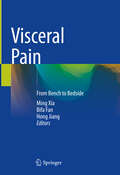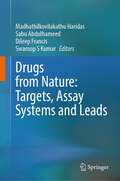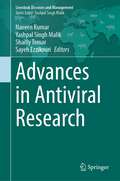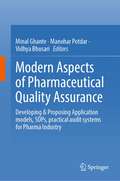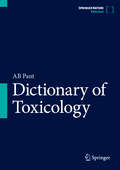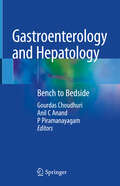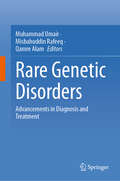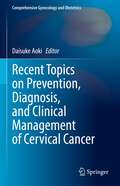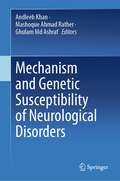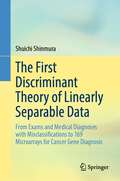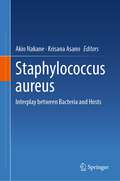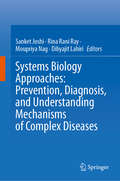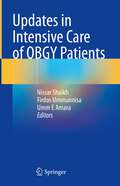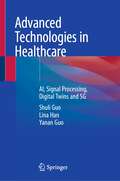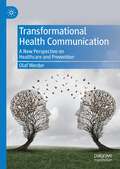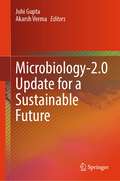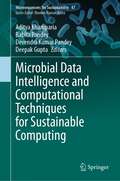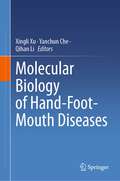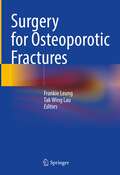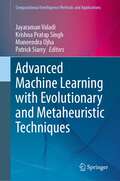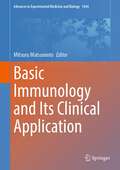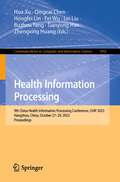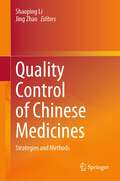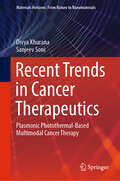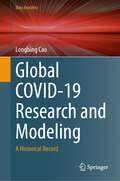- Table View
- List View
Visceral Pain: From Bench to Bedside
by Hong Jiang Ming Xia Bifa FanPatients with chronic visceral pain present a challenge for medical providers because of their vague presenting symptoms and frequent lack of identifiable pathology. Despite this, chronic visceral pain can be a debilitating medical condition that increases morbidity and decreases quality of life; the long-term consequences of which cause significant socioeconomic burden and debility. Covering the newest trends, studies, diagnosis and treatments in visceral pain care, as well as the pain treatment strategies that have been successfully employed in the past, this book brings readers fully up to date with effective recognitions and treatments for visceral pain. The clinical evaluation and presentation of common chronic visceral pain conditions and multimodal treatment options that can be used to assist patients and providers are focused.
Drugs from Nature: Targets, Assay Systems and Leads
by Madhathilkovilakathu Haridas Sabu Abdulhameed Dileep Francis Swaroop S KumarThis book provides an overview of the drug discovery process from natural sources such as plants and microbes. While technological advances have streamlined the drug discovery process, enhancing the throughput and success rates, the structural features of natural products remain the primary reference for small-molecule drug discovery. Focusing on the drug targets blocked/altered by natural/nature-inspired molecules, it covers how potential drug leads are screened and identified using appropriate assay systems, and the current status of drugs identified using such approaches. State-of-the-art approaches in target identification, assay development, and lead identification have also been discussed in detail. Other topics included are targets and leads in inflammation, cancer, reproductive medicine, cardiovascular and neuromuscular ailments, and infectious diseases as well as the challenges in translating drug leads into clinically viable drugs. This volume serves as a handbook for researchers in phytochemistry and drug discovery, and as a reference for researchers and students of applied biology.
Advances in Antiviral Research (Livestock Diseases and Management)
by Naveen Kumar Yashpal Singh Malik Shailly Tomar Sayeh EzzikouriThis book illustrates advancements in the sophisticated tools and techniques for discovering and designing new antiviral drugs, identifying approved drugs against new and emerging viruses through large-scale computational virtual screening or drug repurposing approaches, and their evaluation in various in vitro and in vivo models. The chapters also cover the challenges associated with the emergence of antiviral drug resistance and possible ways to counter them. It discusses bioinformatics tools and software and computational approaches for the discovery of antivirals. The books also outline approaches for designing broad-spectrum antivirals effective against viruses by epigenetic- and epitranscriptomic-targeted reprogramming. Further, it provides vital details on the procedures for drug applications, clinical trials, and their regulations. Finally, the book provides a comprehensive yet representative description of advances in antiviral research protocols and methodologies suitablefor antiviral researchers at all career stages, including graduate and postgraduate students and policy-makers.
Modern Aspects of Pharmaceutical Quality Assurance: Developing & Proposing Application models, SOPs, practical audit systems for Pharma Industry
by Minal Ghante Manohar Potdar Vidhya BhusariThe pharmaceutical quality system ensures that the process performance is suitably achieved, the product quality is regularly met, improved opportunities are identified and evaluated, and the knowledge is constantly expanded. Auditing also plays a crucial role within the pharmaceutical industry. It helps to assess and review quality to improve and build a better system for the benefit of companies. This book aims to develop a tool that will substantially decrease the number of Inspectional Observations and Warning letters, thus eliminating Import Alerts and Consent Decree. This book targets the Pharmaceutical Industry and students of Pharmaceutical Quality Assurance so they can get in hand-ready consolidated information on Pharmaceutical Quality guidelines, Quality metrics, and implementation of simplified SOP guidelines, plant layouts to implement Quality metrics for Pharmaceutical Manufacturing systems in tablets, capsules, liquid orals, and semi-solid dosage forms. The chapters cover the various aspects of Pharmaceutical Quality Assurance. The selection of topics is mainly based on the requirements of Pharmaceutical regulatory guidelines of India, the UK, the USA, Australia, and South Africa. Each chapter includes the abstract, detailed explanation, implementation guidelines, flowcharts, layouts, and Standard Operating Procedure of quality metrics for the Pharmaceutical Manufacturing System
Dictionary of Toxicology
by AB PantThis dictionary of toxicology provides curated and authentic information on the terminologies used with their description as per modern toxicology and associated declines. It aims to have a collection of over 3500 terminologies with their basic information and roles with relevance in toxicology and associated disciplines in alphabetical order. This book has a flow of information in alphabetical order starting from word A to Z. The contents cover all the possible facets of contemporary. It is an unparalleled reservoir of information with a practical understanding of the subject for undergraduates, post-graduate, doctorate and post-doctorate, researchers of toxicology, medical and dental sciences, veterinary sciences, pharmacy sciences, life sciences, forensic sciences, etc. Besides this, target readers would also be personnel working in academia, pharma industries, contract research organizations involved in regulatory studies, regulatory agencies and implementing agencies, and people having an interest in toxicological sciences.
Gastroenterology and Hepatology: Bench to Bedside
by Gourdas Choudhuri Anil C Anand P PiramanayagamThe book aims to be a handy compendium to the very voluminous texts of gastroenterology and hepatology existing in the knowledge market and provides the reader with an easy understanding of the bench knowledge (basic sciences) as they apply to bedside practice (clinical gastroenterology). With introduction and contributions from Prof Eamon Quigley, Former president of World Gastroenterology Organization and American College of Gastroenterology, the book covers the recent advances in the basic sciences that form an important pillar of the knowledge, thereby linking basic sciences such as anatomy, physiology, biochemistry, molecular medicine, etc. to clinical conditions, diseases and new therapeutic approaches in gastroenterology and hepatology. The book is written in a simple easy to read format, with a lot of diagrams and flowcharts, making it a handy guide. It also discusses in-depth about very common clinical conditions encountered in hospital settings such as ulcerative colitis, pseudomembranous colitis, colonic cancer, amebiasis, and various other syndromes and diseases. This book is a useful read for fellows and trainees in Gastroenterology and Hepatology, as well as gastroenterologists, hepatologists and physicians interested in digestive disorders.
Rare Genetic Disorders: Advancements in Diagnosis and Treatment
by Muhammad Umair Misbahuddin Rafeeq Qamre AlamThis book introduces different Rare Genetic Disorders (RGDs), and challenges in their diagnosis. The chapters of the book discuss the emerging research and clinical approaches for the diagnosis of rare genetic disorders. It further reviews the future of genetic therapies for the treatment of rare genetic diseases and examine the recent advancements in the field of genetic testing for the diagnosis of these diseases. The book also covers the role of variants in the genome (genetic modifiers) that alleviate (suppress) or exacerbate (enhance) the severity of the disease, resulting in the variability of phenotypic outcomes. Further, the book examines different animal models for critical understanding of disease mechanisms, and the opportunity to evaluate the effect of therapeutic compounds in pre-clinical studies. The subsequent chapters present the state-of-the-art drug discovery strategies and biological approaches for the treatment of rare genetic disorders. Towards the end, the book reviews the current challenges in the diagnosis and treatment of the patients of rare genetic disorders and future opportunities. This book is useful for clinical geneticists, molecular and biochemical geneticists, researchers working in gene therapy and genome editing.
Recent Topics on Prevention, Diagnosis, and Clinical Management of Cervical Cancer (Comprehensive Gynecology and Obstetrics)
by Daisuke AokiThis book provides a practical overview of a central topic in cervical cancer concerning human papillomavirus (HPV), prevention, cervical cancer screening, diagnosis, and treatment. Since the finding of human papillomavirus (HPV) being the cause of cervical cancer and its precursor symptoms, effective screening based on HPV DNA testing and prevention methods by HPV vaccination are established. Furthermore, new surgical methods, radiation therapy, and drug therapy are developed. To summarize the history and the recent advancement, this book is presented in five attractive parts: pathogenesis and epidemiology, cancer screening and prevention strategies, diagnosis and clinical management of cervical intraepithelial neoplasia (CIN), surgical treatments, and multimodal therapy. Recent Topics on Prevention, Diagnosis, and Clinical Management of Cervical Cancer is an appealing source for gynecologists, gynecologic surgeons, gynecologic pathologists, and gynecologic, clinical, and radiation oncologists. Also, primary care doctors, public health nurses, nurses, and pharmacists involved in cancer and other medical personnel will find the information and challenges presented tempting.
Mechanism and Genetic Susceptibility of Neurological Disorders
by Andleeb Khan Mashoque Ahmad Rather Ghulam Md AshrafThis book is about the "Mechanism and Genetic susceptibility of Neurological disorders. It is a comprehensive exploration, penned by esteemed authors, and offers a profound understanding of these enigmatic ailments, their progression, and the strategic approaches employed to mitigate their impact. In this book, readers will uncover a wealth of knowledge surrounding the mechanistic intricacies that underlie various neurological disorders. Through meticulous research and insightful analysis, the authors elucidate the inner workings of these conditions, shedding light on the mechanisms responsible for their onset and progression. The central themes of this book are the recognition of the genetic landscape governing neurological disorders. It emphasizes the role played by a diverse array of genes in the development and progression of these conditions, highlighting the multifaceted genetic susceptibility that underlies their manifestation.
The First Discriminant Theory of Linearly Separable Data: From Exams and Medical Diagnoses with Misclassifications to 169 Microarrays for Cancer Gene Diagnosis
by Shuichi ShinmuraThis book deals with the first discriminant theory of linearly separable data (LSD), Theory3, based on the four ordinary LSD of Theory1 and 169 microarrays (LSD) of Theory2. Furthermore, you can quickly analyze the medical data with the misclassified patients which is the true purpose of diagnoses. Author developed RIP (Optimal-linear discriminant function finding the combinatorial optimal solution) as Theory1 in decades ago, that found the minimum misclassifications. RIP discriminated 63 (=26−1) models of Swiss banknote (200*6) and found the minimum LSD: basic gene set (BGS). In Theory2, RIP discriminated Shipp microarray (77*7129) which was LSD and had only 32 nonzero coefficients (first Small Matryoshka; SM1). Because RIP discriminated another 7,097 genes and found SM2, the author developed the Matryoshka feature selection Method 2 (Program 3), that splits microarray into many SMs. Program4 can split microarray into many BGSs. Then, the wide columnLSD (Revolution-0), such as microarray (n Theory3 shows the surprising results of six ordinary data re-analyzed by Theory1 and Theory2 knowledge. Essence of Theory3 is described by using cephalopelvic disproportion (CPD) data. RIP discriminates CPD data (240*19) and finds two misclassifications unique for cesarean and natural-born groups. CPD238 omitting two patients becomes LSD, which is the first case selection method. Program4 finds BGS (14 vars.) the only variable selection method for Theory3. 32 (=25) models, including BGS, become LSD among (219−1) models. Because Program2 confirms BGS has the minimum average error rate, BGS is the most compact and best model satisfying Occam’s Razor. With this book, physicians obtain complete diagnostic results for disease, and engineers can become a true data scientist, by obtaining integral knowledge ofstatistics and mathematical programming with simple programs.
Staphylococcus aureus: Interplay between Bacteria and Hosts
by Akio Nakane Krisana AsanoStaphylococcus aureus is an opportunistic human pathogen that colonizes the mucosal surfaces. It is the causative agent of various serious acute and chronic infections. Recent prevalence of infectious diseases caused and expanded by hospital-acquired methicillin-resistant S. aureus (HA-MRSA), community-acquired methicillin-resistant S. aureus (CA-MRSA) and livestock-acquired methicillin-resistant S. aureus (LA-MRSA). MRSA infections must be more serious problem in near future. It is presumed that offense and defense responses are continuously executed between S. aureus and host to establish and maintain commensalism for S. aureus. Therefore, it is essential to elucidate interplay between S. aureus and hosts to prevent staphylococcal infectious diseases. This book is comprised of content that focuses on this aspect.
Systems Biology Approaches: Prevention, Diagnosis, and Understanding Mechanisms of Complex Diseases
by Sanket Joshi Rina Rani Ray Moupriya Nag Dibyajit LahiriThis book examines the development and applications of system biology approaches for the prevention, diagnosis, and understanding of disease mechanisms. It explores the applications of system biology in infectious diseases, including host-pathogen interaction, and the identification of targets for new therapeutics and intervention strategies. It covers the use of system biology for understanding and treating metabolic disorders towards personalized and precision medicine. The book further discusses the systems biology approaches for understanding the mechanisms of tumor progression and designing more effective cancer therapies. The chapter also reviews the current strategies in autoimmune disease treatment and highlights the opportunity that systems biology represents for the development of better and safer treatments. Importantly, the book discusses the current state of the systems-level understanding of diseases and both the therapeutic and adverse mechanisms of drug actions usingsystem biology approaches. Cutting across the disciplines, this book is a valuable source for researchers in genetics, molecular biology, cell biology, microbiology, and biomedical sciences.
Updates in Intensive Care of OBGY Patients
by Nissar Shaikh Firdos Ummunnisa Umm E AmaraThis book presents the updated management of acute and critically ill obstetric and gynecological patients. It describes patients' care with pregnancy-induced medical disorders, comorbidities, and gynecological (OBGY) conditions requiring acute and intensive care support therapy. This book will guide early diagnosis and speedy management of life-threatening conditions. Chapters provide a comprehensive and systemic approach in an easy-to-understand format. Along with diseases and comorbidities of pregnancy, acute illness and its management caused by in vitro fertilization (IVF) are focused on, and a dedicated chapter about COVID-19 infection in obstetric patients is provided.Updates in Intensive Care of OBGY Patients will support intensivists, obstetricians, gynecologists, acute care physicians, and surgeons. Residents, fellows, specialists, and other junior medical staff working in intensive care units will also value this source. It will also help to broaden the understanding of nurses and paramedical staff in intensive care therapy.
Advanced Technologies in Healthcare: AI, Signal Processing, Digital Twins and 5G
by Shuli Guo Lina Han Yanan GuoThis book explores the applications of cutting-edge technologies such as AI, blockchain, signal processing, digital twin technology, and 5G communication technology in healthcare. The writing style combines diagrams, tables, formulae, and text to enhance readability. The content combines theoretical analysis and medical application in every chapter. This book presents several innovative methods, including an AI-based computer-aided diagnosis system, a blockchain-based AI system framework for healthcare, pre-processing algorithms for medical imaging, digital twin models for healthcare, a healthcare platform based on cloud, fog, and edge computing, and a personal health device domain information model. This book will be valuable for researchers, engineers, and post-graduate students in the fields of medicine management and software engineering.
Transformational Health Communication: A New Perspective on Healthcare and Prevention
by Olaf WerderThis book advances our understanding of communicative relationships and key barriers to more effective health communication. In this, it offers a humanistic orientation of health communication as well as its social, cultural, political, ethical, and spiritual dimensions and contexts. The book therefore brings a more inclusive and integrated approach to the major challenges and opportunities in contemporary health, medicine, and wellbeing.
Microbiology-2.0 Update for a Sustainable Future
by Juhi Gupta Akarsh VermaThis book demonstrates the extremely fascinating and interdisciplinary microbial domain. It helps in discovering the latest advances in microbiology and learns how they can help shape a more sustainable future for our planet. This comprehensive guide covers the latest breakthroughs in microbiology research and their practical applications in fields such as ecology, agriculture, biotechnology, and environmental science. Furthermore, the readers explore the cutting-edge technologies and methodologies that are driving the next generation of microbiology research. With expert insights from the leading microbiologists, this book is an essential resource for anyone interested in understanding the role of microbes in our world and harnessing their power for a better tomorrow.
Microbial Data Intelligence and Computational Techniques for Sustainable Computing (Microorganisms for Sustainability #47)
by Aditya Khamparia Babita Pandey Devendra Kumar Pandey Deepak GuptaThis book offers information on intelligent and computational techniques for microbial data associated with plant microbes, human microbes etc. The main focus of this book is to provide an insight on building smart sustainable solutions for microbial technology using intelligent computational techniques. Microbes are ubiquitous in nature, and their interactions among each other are important for colonizing diverse habitats. The core idea of sustainable computing is to deploy algorithms, models, policies and protocols to improve energy efficiency and management of resources, enhancing ecological balance, biological sustenance and other services on societal contexts. Chapters in this book explore the conventional methods as well as the most recently recognized high-throughput technologies which are important for productive agroecosystems to feed the growing global population. This book is of interest to teachers, researchers, microbiologist, computer bioinformatics scientists,plant and environmental scientist, and those interested in environment stewardship around the world. The book also serves as an advanced textbook material for undergraduate and graduate students of computer science, biomedicine, agriculture, human science, forestry, ecology, soil science, and environmental sciences and policy makers.
Molecular Biology of Hand-Foot-Mouth Diseases
by Xingli Xu Yanchun Che Qihan LiThis book aims to compile the latest scientific information on hand, foot, and mouth disease (HFMD), including its epidemiology, etiology, pathology, immune response and vaccine development. Interestingly, the authors shared their own research experience and offered distinctive insights into the pathogenesis of HFMD and vaccine development. The intended audience, including university researchers, graduate students, and vaccine engineers, is well defined. The book is positioned as a resource that not only presents current knowledge but also has the potential to inspire further research in understanding immune pathogenesis and advancing vaccine development for HFMD.
Surgery for Osteoporotic Fractures
by Frankie Leung Tak Wing LauThis book introduces recent advances in implants and surgical techniques for osteoporotic fractures. It covers most frequent fractures especially in the geriatric population, such as fractures of the hip, distal radius, proximal humerus, peri-prosthetic fractures and drug associated atypical femoral fractures, etc. The book details special surgical techniques which are required to treat these challenging and complex fractures. It also covers the current concept of geriatric fracture care and encompasses the holistic management of these patients from surgical management of the fracture to rehabilitation and prevention of subsequent fragility fractures.
Advanced Machine Learning with Evolutionary and Metaheuristic Techniques (Computational Intelligence Methods and Applications)
by Jayaraman Valadi Krishna Pratap Singh Muneendra Ojha Patrick SiarryThis book delves into practical implementation of evolutionary and metaheuristic algorithms to advance the capacity of machine learning. The readers can gain insight into the capabilities of data-driven evolutionary optimization in materials mechanics, and optimize your learning algorithms for maximum efficiency. Or unlock the strategies behind hyperparameter optimization to enhance your transfer learning algorithms, yielding remarkable outcomes. Or embark on an illuminating journey through evolutionary techniques designed for constructing deep-learning frameworks. The book also introduces an intelligent RPL attack detection system tailored for IoT networks. Explore a promising avenue of optimization by fusing Particle Swarm Optimization with Reinforcement Learning. It uncovers the indispensable role of metaheuristics in supervised machine learning algorithms. Ultimately, this book bridges the realms of evolutionary dynamic optimization andmachine learning, paving the way for pioneering innovations in the field.
Basic Immunology and Its Clinical Application (Advances in Experimental Medicine and Biology #1444)
by Mitsuru MatsumotoThis book overviews ongoing and upcoming clinical applications of basic immunology. Recent advances in our knowledge of immunology coupled with new technologies have aided in the development of efficient cancer immunotherapy, as well as the control of emerging microorganisms such as SARS-CoV-2. However, knowledge of basic immunology has not been fully utilized even after the discoveries of immune checkpoint inhibition for cancer immunotherapy and the development of mRNA vaccination against SARS-CoV-2. There is still room for improving the clinical application of basic immunology. The book summarizes the achievements in clinical applications of basic immunology and highlights what can be further extended to make immunology a more practical human science. Basic immunology and its clinical applications are two wheels of the same cart in the immunology field, which aids in the development of more efficient cancer immunotherapy and rapid control of infectious diseases against microorganisms, including new viruses and classical toxoplasmosis. The exploration of ongoing and upcoming applications of basic immunology in this book makes it a useful resource for immunologists, physicians, molecular and genome biologists, bioinformaticians, and students in these fields.
Health Information Processing: 9th China Health Information Processing Conference, CHIP 2023, Hangzhou, China, October 27–29, 2023, Proceedings (Communications in Computer and Information Science #1993)
by Hua Xu Qingcai Chen Hongfei Lin Fei Wu Lei Liu Buzhou Tang Tianyong Hao Zhengxing HuangThis book constitutes the refereed proceedings of the 9th China Health Information Processing Conference, CHIP 2023, held in Hangzhou, China, during October 27–29, 2023. The 27 full papers included in this book were carefully reviewed and selected from 66 submissions. They were organized in topical sections as follows: healthcare information extraction; healthcare natural language processing; healthcare data mining and applications.
Quality Control of Chinese Medicines: Strategies and Methods
by Jing Zhao Shaoping LiThis book focuses on the strategies and methods for quality control of Chinese medicines used in prevention and treatment of diseases for thousands of years in China and East Asia. It explains various strategies and methods for quality markers discovery and herbal glycoanalysis, as well as practices for control of heavy metal and pesticide residues. Strategies to overcome the shortage of reference compounds for quality control of Chinese medicines are also provided. The book also introduces analytical techniques for different analytes in Chinese medicines with an emphasis on sample preparation in automation and high extraction efficiency methods, the key process affecting the time and accuracy of the techniques. It is of interest to quality control scientists in academia and industry working on Chinese medicines and/or herbal medicine and also pharmacists, pharmacologists, food chemists, and nutritionists who want to understand Chinese medicines.
Recent Trends in Cancer Therapeutics: Plasmonic Photothermal-Based Multimodal Cancer Therapy (Materials Horizons: From Nature to Nanomaterials)
by Divya Khurana Sanjeev SoniThis book describes the plasmonic photothermal-assisted multimodal cancer therapeutics in the area of cancer nanotechnology or cancer nanomedicine. This book covers the fundamentals of plasmonic photothermal cancer therapy as well as plasmonic photothermal mediated multimodal cancer therapy. The various steps involved in developing such therapeutic modality, viz. (a) the selection of suitable nanoparticles, (b) synthesis of multifunctional nanocomposite, (c) optimization of the photosensitizer and chemotherapeutic drug loadings, (d) characterization of the synthesized nanocomposite, and (e) therapeutic evaluations through novel tumor-tissue mimicking phantoms and the cancer cell lines are discussed in detail. Apart from the detailed description of therapeutic outcome, this book provides a step-by-step approach to develop a multifunctional nanocomposite for such therapeutics. Overall, this book provides simplified and in-depth information about cancer nanobiotechnology to the researchers and graduate students in subject areas of nanotechnology, biotechnology and pharmaceutics to develop and contribute to such multimodal cancer therapeutics.
Global COVID-19 Research and Modeling: A Historical Record (Data Analytics)
by Longbing CaoThis book provides answers to fundamental and challenging questions regarding the global response to COVID-19. It creates a historical record of COVID-19 research conducted over the four years of the pandemic, with a focus on how researchers have responded, quantified, and modeled COVID-19 problems. Since mid-2021, we have diligently monitored and analyzed global scientific efforts in tackling COVID-19. Our comprehensive global endeavor involves collecting, processing, analyzing, and discovering COVID-19 related scientific literature in English since January 2020. This provides insights into how scientists across disciplines and almost every country and regions have fought against COVID-19. Additionally, we explore the quantification of COVID-19 problems and impacts through mathematics, AI, machine learning, data science, epidemiology, and domain knowledge. The book reports findings on publication quantities, impacts, collaborations, and correlations with the economy and infectionsglobally, regionally, and country-wide. These results represent the first and only holistic and systematic studies aimed at scientifically understanding, quantifying, and containing the pandemic. We hope this comprehensive analysis will contribute to better preparedness, response, and management of future emergencies and inspire further research in infectious diseases. The book also serves as a valuable resource for research policy, funding management authorities, researchers, policy makers, and funding bodies involved in infectious disease management, public health, and emergency resilience.
